Written by and Photos by Michelle Lamphere. Posted in Rides
As the dust clears, I try to find my bearings and do a self-assessment. I’ve just finished skidding to a stop on a gravel road on the edge of nowhere. My Kawasaki KLR650 is lying on its left side about eight feet ahead in the middle of the road, but luckily is in no danger with the lack of traffic in Labrador. I feel okay—other than the adrenaline overload.
This open stretch of the Trans-Labrador Highway (TLH) is on a plateau and the strong gusts of wind combine with the crushed rock road surface to make the riding challenging. The road was freshly graded but deeply corrugated over the last 30–40 miles. And, when a strong gust blew from my right, I counterbalanced just before the wind suddenly dropped. Compensating instantly turned into overcompensating, which triggered several seconds of tank slapping before down I went. That’s it. But that’s all it takes.
Removing my helmet, I take off my gloves and check myself over. Nothing seems wrong, but when I move to stand up something isn’t right. My left leg feels strange and doesn’t respond normally. Instinctively I don’t move it and don’t try to get up. I know it’s broken and needs medical attention. There’s a satellite phone strapped to the back of my bike and, if I can get to it, I can call for help.
The tank bag is stocked with an emergency blanket for the cold, and an air horn that will hopefully scare bears away. All this runs through my head in less than a minute as I watch my riding partner’s dust trail disappear over the hill. Brian will be back. In the meantime I need to figure out what to do.
Just over two weeks before, we took off from my home in western South Dakota for a one-year ride. I’d left a 20-plus year career and was taking some time off to get out and play. My job had been my focus for many years, and I reasoned that I hadn’t made enough time to relax and enjoy life. Although I’d been mainly riding cruisers for years, I had purchased my first dual-sport that may have been at least partially responsible for this line of thinking. So, following the clichéd, “If I can do it, anyone can,” of many riders before me, and after two years of preparations, I sold my house, packed up my gear and hit the road for points unknown.
I had ridden over 3,200 miles to get to this point, about 100 miles southeast of Goose Bay on the TLH. This 240-mile section, Phase Three, is the newest, having opened in December 2009. Part of the new road which lies between Goose Bay and Port Hope-Simpson, it is the longest stretch without services or towns. For the last 700 miles (around the Manic-5 Dam) we had seen few towns or fuel stations. S.O.S. phone booths were located approximately every 70 miles, and satellite phones are provided free of charge to travelers. Signs warn of scarce services—indications of the remoteness of this part of the world, and the seriousness with which one must prepare to ride the TLH.
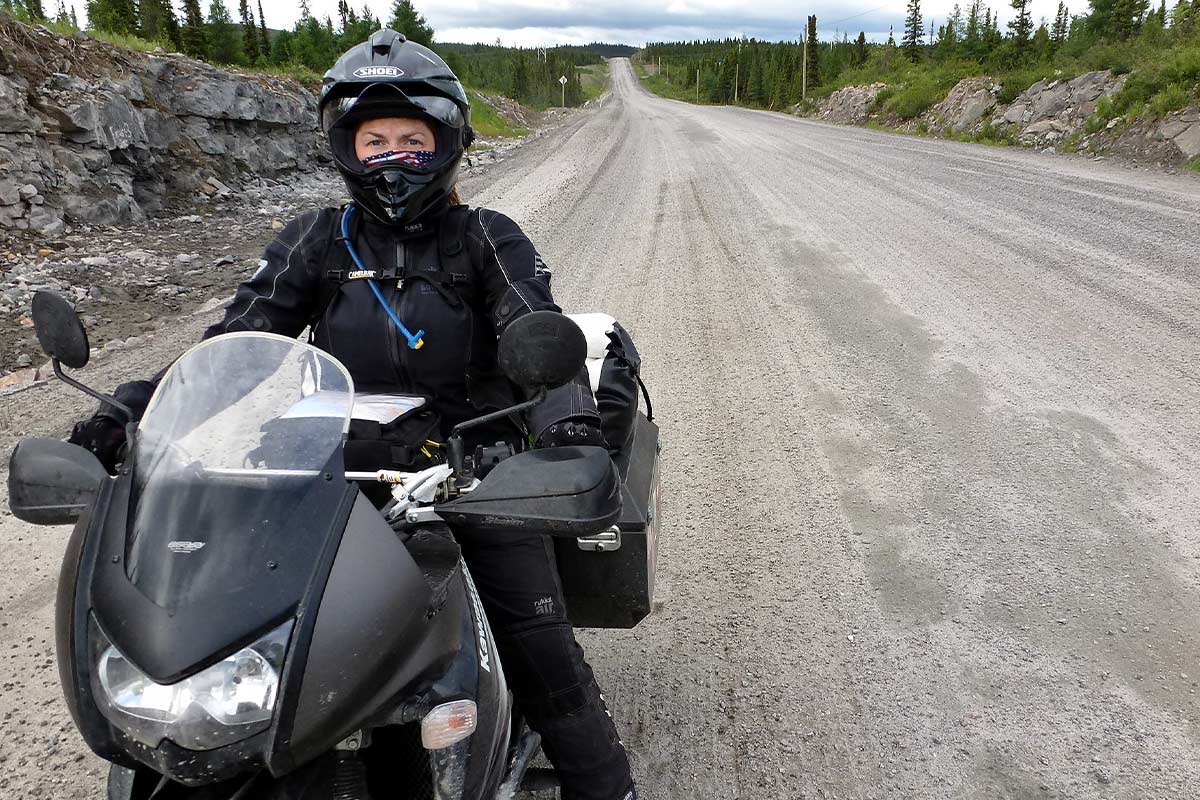 Riding my KLR650 on the Trans-Labrador Highway (TLH) between Churchill Falls and Happy Valley-Goose Bay, Labrador.
Riding my KLR650 on the Trans-Labrador Highway (TLH) between Churchill Falls and Happy Valley-Goose Bay, Labrador.
Just when the reality of my situation begins to sink in, and as I ponder the obstacle of getting to the sat phone, a man walks up, seemingly out of nowhere, and asks if I’m all right. The Royal Canadian Mounted Police are the first on the scene. Seriously?! How lucky can a girl be? The relief I feel is immediate and for the first time I relax just a bit from being in hyper-alert survival mode. The officer retrieves several emergency blankets from his car and calls an ambulance. He asks if my injuries require a helicopter evacuation or if I can wait for an ambulance to drive out from Goose Bay. I tell him that I don’t think the fracture is compound, and that a helicopter isn’t necessary.
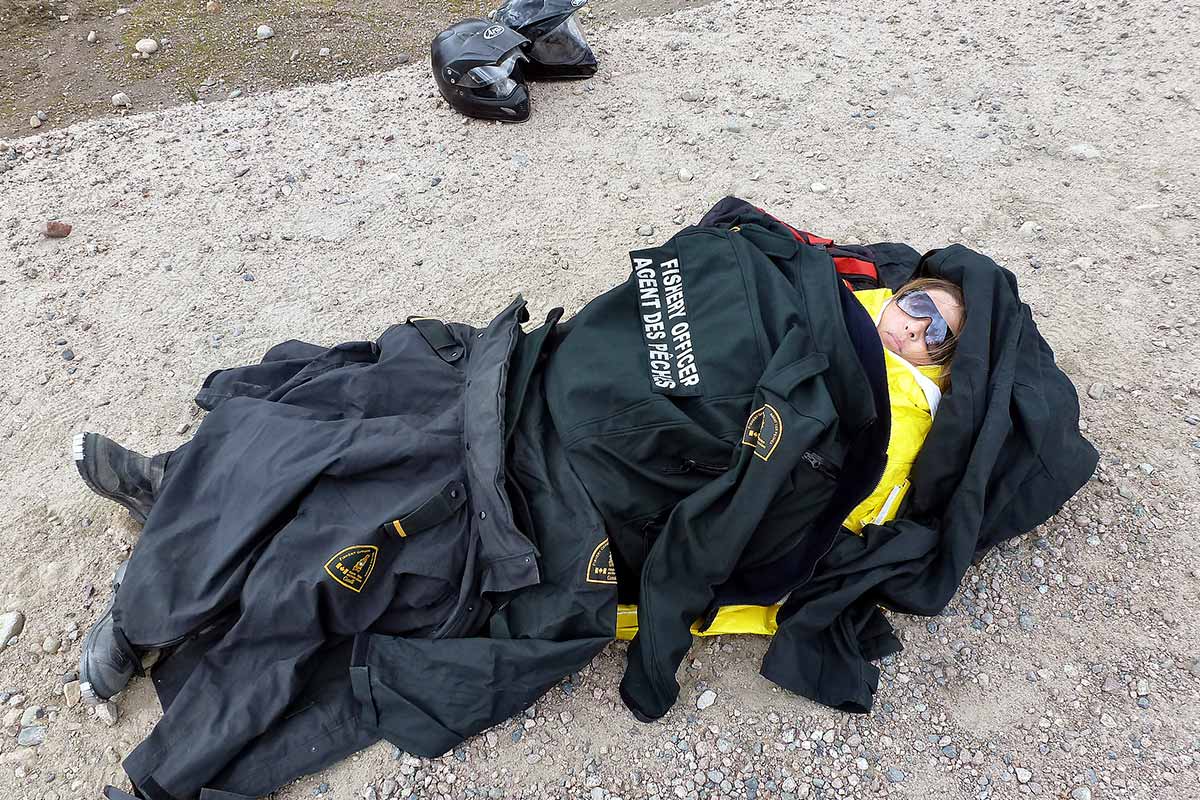 Thanks to the RCMP and Fisheries and Oceans officers who built this windbreak, I was protected from the wind while waiting more than two hours for the ambulance.
Thanks to the RCMP and Fisheries and Oceans officers who built this windbreak, I was protected from the wind while waiting more than two hours for the ambulance.
A cargo truck arrives from the direction I’d been heading. As the driver and the officer move my bike from the middle of the road to the shoulder, the damage looks minimal except for my left pannier, which took the brunt of the fall. A few minutes later, and just as Brian returns, a pickup pulls in behind the cargo truck and two Fisheries and Oceans Canada officers assist. The strong, gusty crosswind that played a role in my crash at least keeps the blackflies away, but now, as the adrenaline spiking slows, I’m beginning to feel the cold—causing concern that I may go into shock.
Even with all my gear, liners and several emergency blankets, I’m chilled and shaking. The men build a windbreak and cover me with their coats to keep me as sheltered as possible. We wait over two hours for the ambulance to arrive and then it’s another two-hour drive back to Goose Bay over the bumpy gravel road to the nearest hospital.
The X-rays reveal I have broken both my left tibia and fibula in spiral fractures. Surgery is needed, which means I’ll have to be flown to St. John’s, Newfoundland, to the nearest orthopedic surgeon. An air ambulance is requested for the following day as I settle into a room for the night.
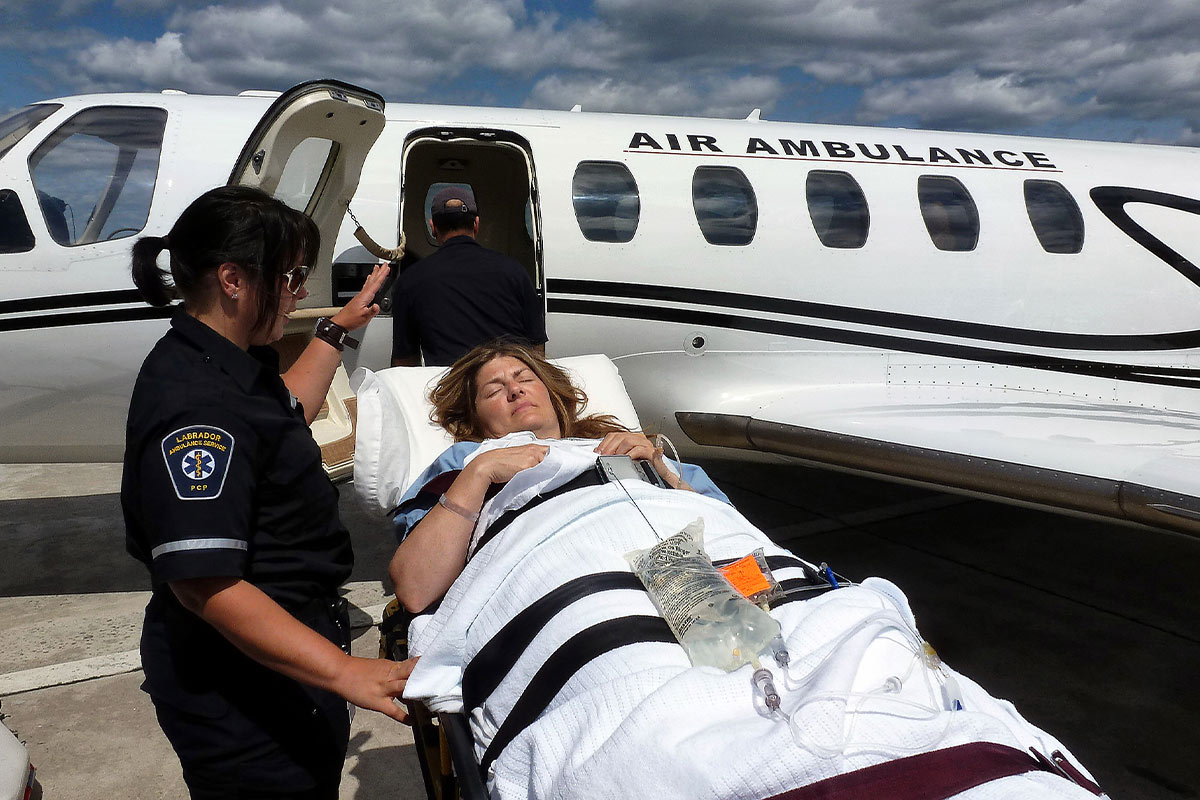 Boarding the medical transport jet, to be flown to Newfoundland for surgery.
Boarding the medical transport jet, to be flown to Newfoundland for surgery.
The driver of the cargo truck offers to haul the KLR back to Goose Bay and store it until I can make necessary arrangements. Brian rides from the accident site more than 100 miles back to town and arrives shortly after my ambulance. I give him the latest news and we make a quick plan for communications and logistics, and discuss posting a request for help on a local ADV Rider forum, which Brian takes care of after leaving me in a morphine-induced sleep.
Within days, we have all kinds of offers from local people—to haul and store my bike, even for Brian and me to stay in local homes until I am able to travel again. The response and support are absolutely overwhelming.
After surgery, which involves a titanium rod and screws, I spend a few days in the hospital before Brian arrives. We debate returning home to South Dakota for recovery, but I am only too aware that I’ll have to return at some point to retrieve my bike to continue this journey. Ten weeks in Newfoundland sounds better than going home on crutches only to return a few weeks later, anyway. So, after discussing my recovery timeline with the doctor, we decide to stay in Newfoundland until the leg heals sufficiently to get back on the road.
In the meantime, we’re invited to move in with a local rider, whose generosity and hospitality go beyond words. Adding to that, the cargo truck driver stores my bike for a couple of weeks, keeping all my gear safe. Another Goose Bay rider then hauls my bike over 1,000 miles to St. John’s, delivering it to the home of another rider who keeps the bike for me while allowing full use of his shop and tools—not to mention taking us on several daytrips around Newfoundland. All this while yet another kind soul gives us use of his beach cabin so that I may still enjoy summer while recuperating! Need I say more? This Canadian network of biker brethren becomes my refuge.
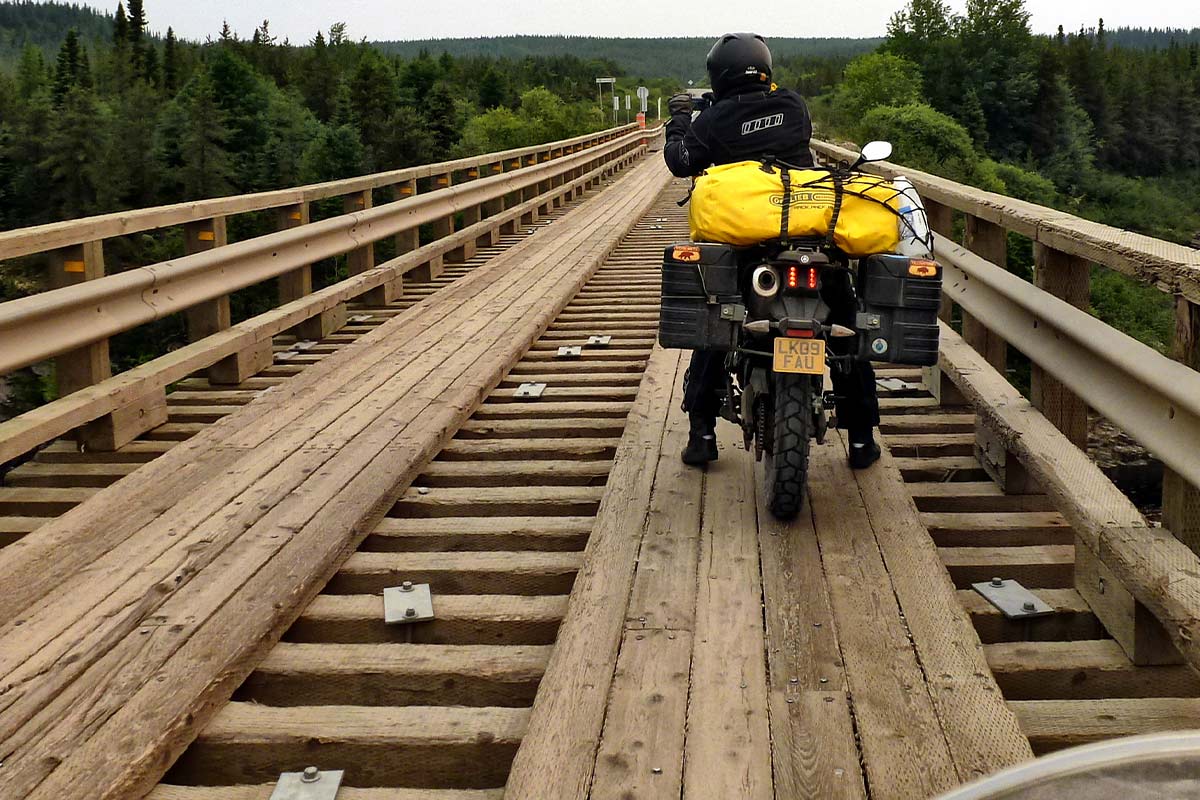 Crossing the Hart Jaune River between Relais Gabriel, Quebec and Labrador City, Labrador on the way to the TLH.
Crossing the Hart Jaune River between Relais Gabriel, Quebec and Labrador City, Labrador on the way to the TLH.
In this way my accident is serendipitous—and so marked by the friends made and the opportunities to experience more of Newfoundland and Labrador than I would ever have if the original planned route and schedule had not been interrupted.
I’m consider myself an adventurer/traveler who rides, more than a typical rider. Cultures, people, music, food and landscapes are more important to me than trail difficulties, miles logged, ride reports and mechanics.
Yet, this accident forced me to spend time in a land I would otherwise not have gotten to know as well, and helped me to see the way I want to travel—at a slower pace, with less schedule and more spontaneity, less self-contained and more connected. Soaking in the places I visit and meeting fellow riders are the new preferences I’ve uncovered through this experience. And, I’m reminded to help other riders whenever I can, to participate in forums, national and local, even when I am not on the road.
“Paying it forward” has always been my nature, especially with regard to fellow riders, but now I’m even more conscious of finding opportunities to do so.
Helping others is a way of life in Newfoundland and Labrador, a necessity for survival in this harsh land that’s still being refined after hundreds of years. They have a saying here, “There are no strangers, only friends you haven’t met yet.” The people here have been incredibly kind, and I will forever be grateful for their help and friendship.
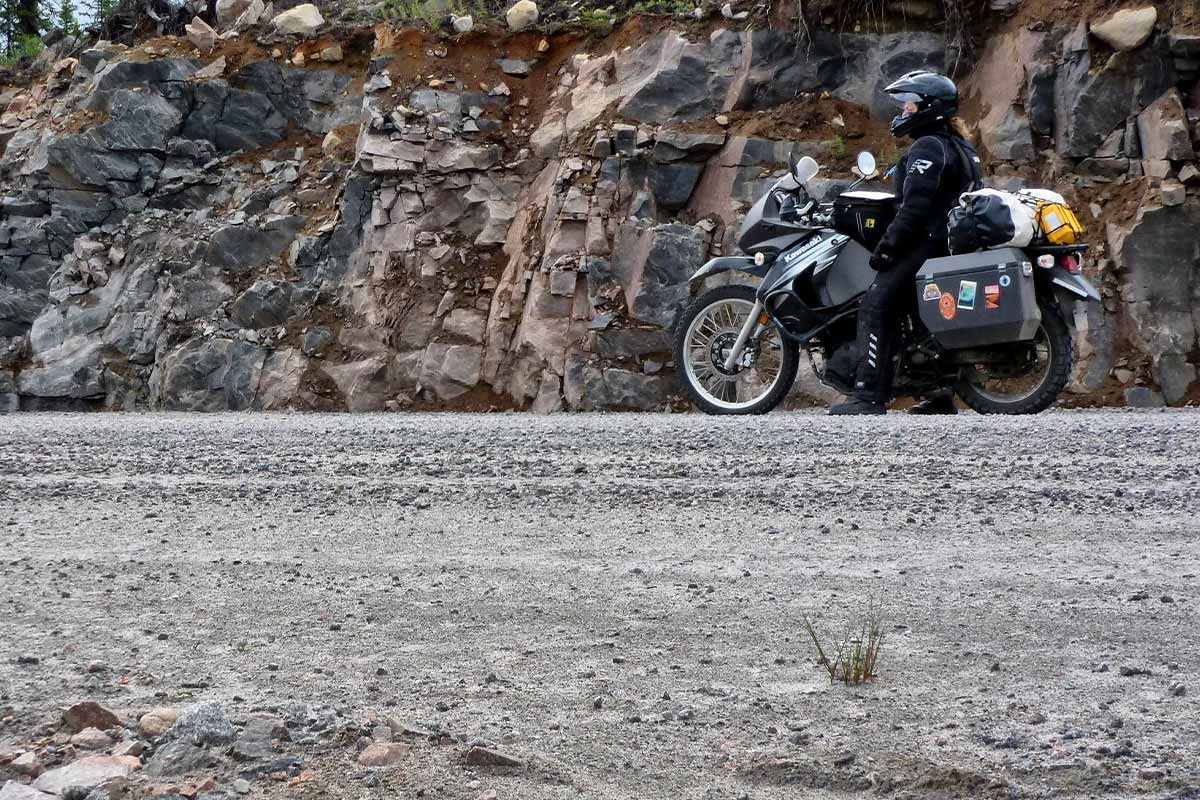 On the TLH between Happy Valley-Goose Bay and Port Hope Simpson in Labrador.
On the TLH between Happy Valley-Goose Bay and Port Hope Simpson in Labrador.
You can read more about my adventures at SturgisChick.com.


